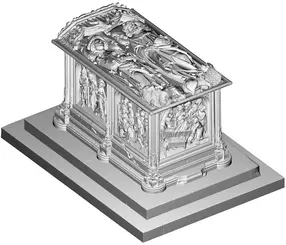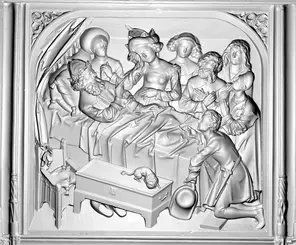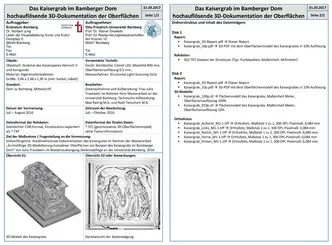Long-Term Archiving of 3D Data
Content and aims
The creation of 3D models of important cultural assets has become a common documentation tool. Especially in recent years, more and more low-cost technologies and open-source software solutions have been developed that allow objects to be digitized and the data to be processed with little effort.
In large research projects, entire scanning lines have even been developed with which museum collections can be captured in the shortest possible time - literally - on an assembly line. The reasons for a three-dimensional acquisition vary enormously; from scientific questions, for which a detailed surface documentation is needed, to the creation of distortion-free orthophotos as a basis for mapping of any kind, to the web-enabled presentation of objects on the websites of museums and collections. The almost complete surface documentation of an object through its digital image is seen as a great advantage, especially for endangered cultural assets, and also frequently serves as a justification for the creation of a 3D model. Individual institutions even go a bit further and are tempted by the ever-improving and higher-resolution 3D documentation techniques to view the 3D digital dataset as a possible replacement for an original:
"In the event of a loss of the original, the photorealistic 3D models mean that the image and form are still available and the context can be understood in the long term. With the help of this digital "3D preservation", objects are preserved for future generations." (Fuhrmann, C./Santos, P./Fellner, D.: 3D-Massendigitalisierung – ein Meilenstein für die museale Nutzung, in: Museumskunde, Bd. 80, H. 1, 2015, S. 58–61.)
A statement that should definitely be viewed critically. Rather, the 3D models should be understood more as a digital reminder of the original at the time of capture or as digital cultural heritage in its own right.
But what exactly happens to the data after it has been created and analyzed? How exactly is the 3D data of significant cultural assets preserved for future generations? National and international cultural portals have taken on this problem and make their data available online to a broad public. However, museums, collections and state offices also have a duty to protect and preserve the digital cultural heritage in the long term. Therefore, copies of the datasets must be permanently preserved in the institutions' archives. In the course of the high-resolution, three-dimensional documentation of the Bamberg Emperor's Tomb, an outstanding masterpiece of medieval sculpture by Tilman Riemenschneider, uniform data formats and a standardized storage structure were defined within the 3D working group of the Bavarian State Office for the Preservation of Historical Monuments (BLfD), with the help of which 3D data are to be archived on durable, glass DVDs. In this way, 3D data of important cultural assets, such as the existing data sets of the Bamberg Rider, the tomb of Pope Clement II, but also newly acquired data will be archived at the BLfD in the future. This will significantly reduce the need for costly and labor-intensive data maintenance, which is required by conventional storage media due to their extremely limited lifespan.
Current publication
Rahrig, Max: Wohin mit all den Scans? – Über die dauerhafte Archivierung von 3D-Daten bedeutender Kulturgüter am Beispiel des Bamberger Kaisergrabs In: Franz, B., Vinken, G. (Hrsg.): Das Digitale und die Denkmalpflege: Bestandserfassung – Denkmalvermittlung – Datenarchivierung – Rekonstruktion verlorener Objekte, Heidelberg: arthistoricum.net, 2017 (Veröffentlichungen des Arbeitskreises Theorie und Lehre der Denkmalpflege e.V., Band 26), S. 130 – 139, 2017.



